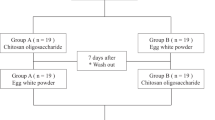Abstract
The effect of chitosan oligosaccharide (GO2KA1) administration on postprandial blood glucose levels of subjects with normal blood glucose levels was evaluated following bread consumption. Postprandial blood glucose levels were determined for 2 h after bread ingestion with or without 500 mg of GO2KA1. GO2KA1 significantly lowered the mean, maximum, and minimum levels of postprandial blood glucose at 30 min after the meal. Postprandial blood glucose levels were decreased by about 25% (from 155.11±13.06 to 138.50±13.59, p<0.01) at 30 min when compared to control. Furthermore, we observed that the area under the concentration-time curve (AUCt) was decreased by about 6% (from 255.46±15.43 to 240.15±14.22, p<0.05) and the peak concentration of blood glucose (C max) was decreased by about 11% (from 157.94±10.90 to 140.61±12.52, p<0.01) when compared to control. However, postprandial the time to reach C max (Tmax) levels were the same as those found in control. Our findings suggest that GO2KA1 limits the increase in postprandial blood glucose levels following bread consumption.
Similar content being viewed by others
References
American Diabetes Association. Diagnosis and classification of diabetes mellitus. Diabetes Care 35(Supplement 1): S64–S71 (2012)
Centers for Disease Control and Prevention. Diabetes Report Card 2014. Atlanta, GA: Centers for Disease Control and Prevention, US Dept of Health and Human Services (2015)
James PB, Theodore JT, Edward WG, Lawrence EB, David FW. Projection of the year 2050 burden of diabetes in the US adult population: Dynamic modeling of incidence, mortality, and prediabetes prevalence. Popul. Health Metrics 8: 29 (2010)
Adam GT, Christian H, Wolfgang R, Eric JB, Mika K. Prediabetes: A high-risk state for diabetes development. Lancet 379: 2279–2290 (2012)
David MN, Rury RH, John BB, Robert S, Mayer BD, Bernard Z, Ele F. Medical management of hyperglycemia in Type 2 diabetes: A consensus algorithm for the initiation and adjustment of therapy. Diabetes Care 32: 193–203 (2009)
Derosa G, Maffioli P. a-Glucosidase inhibitors and their use in clinical practice. Arch. Med. Sci. 8: 899–906 (2012)
No HK, Park NY, Lee SH, Samuel PM. Antibacterial activity of chitosans and chitosan oligomers with different molecular weights. Int. J. Food Microbiol. 74: 65–72 (2002)
Koji H, Mikio I. Action of low molecular weight chitosan in genetically obese diabetic KK-Ay Mice. Biol. Pharm. Bull. 25: 188–192 (2002)
Lee H-W, Park Y-S, Choi J-W, Yi S-Y, Shin W-S. Antidiabetic effects of chitosan oligosaccharides in neonatal streptozotocin-induced noninsulin-dependent diabetes mellitus in rats. Biol. Pharm. Bull. 26: 1100–1103 (2003)
Cynthia MG, Jessa M, Robert HJ, John W, Daniel DG. Cholesterol reduction by glucomannan and chitosan is mediated by changes in cholesterol absorption and bile acid and fat excretion in rats. J. Nutr. 130: 2753–2759 (2000)
Qin C, Du Y, Xiao L, Li Z, Gao X. Enzymic preparation of water-soluble chitosan and their antitumor activity. Int. J. Biol. Macromol. 31: 111–117 (2002)
Qi L, Xu Z. In vivo antitumor activity of chitosan nanoparticles. Bioorg. Med. Chem. Lett. 16: 4243–4245 (2006)
Yen MT, Yang JH, Mau JL. Antioxidant properties of chitosan from crab shells. Carbohyd. Polym. 74: 840–844 (2008)
Tao S, Dongxiang Z, Junlin X, Fang M. Preparation of chitosan oligomers and their antioxidant activity. Eur. Food Res. Technol. 225: 451–456 (2007)
Jo SH, Ha KS, Moon KS, Kim JG, Oh CG, Kim YC, Apostolidis E, Kwon YI. Molecular weight dependent glucose lowering effect of low molecular weight chitosan oligosaccharide (GO2KA1) on postprandial blood glucose level in SD rats model. Int. J. Mol. Sci. 14: 14214–14224 (2013)
Jo SH, Ha KS, Lee JW, Kim YC, Apostolidis E, Kwon YI. The reduction effect of low molecular weight chitosan oligosaccharide (GO2KA1) on postprandial blood glucose levels in healthy individuals. Food Sci. Biotechnol. 23: 971–973 (2014)
Author information
Authors and Affiliations
Corresponding author
Rights and permissions
About this article
Cite this article
Kang, YR., Choi, HY., Lee, JY. et al. Effect of supplementation of low-molecular-weight chitosan oligosaccharide, GO2KA1, on postprandial blood glucose levels in healthy individuals following bread consumption. Food Sci Biotechnol 25, 911–914 (2016). https://doi.org/10.1007/s10068-016-0149-9
Received:
Revised:
Accepted:
Published:
Issue Date:
DOI: https://doi.org/10.1007/s10068-016-0149-9




